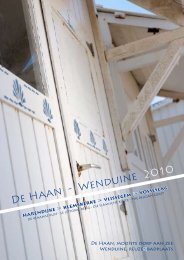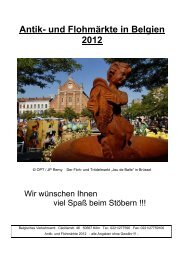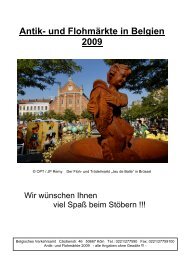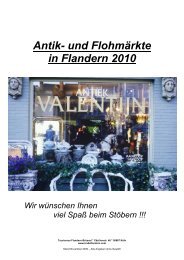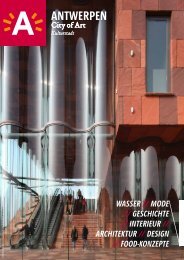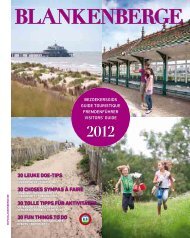Architektur und Skulpturen - Tourismus Flandern-Brüssel
Architektur und Skulpturen - Tourismus Flandern-Brüssel
Architektur und Skulpturen - Tourismus Flandern-Brüssel
Sie wollen auch ein ePaper? Erhöhen Sie die Reichweite Ihrer Titel.
YUMPU macht aus Druck-PDFs automatisch weboptimierte ePaper, die Google liebt.
20<br />
ten das Dekor für ‘Zomer in de Kruidtuin’ dar<br />
(www.zomerindekruidentuin.be): eine Freiluftausstellung<br />
mit Kunstwerken aus dem In- <strong>und</strong><br />
Ausland.<br />
Ein kostenloser geführter Besuch mit einer<br />
Dauer von eineinhalb St<strong>und</strong>en für Gruppen<br />
von 10 bis 30 Personen wird von den Gärtnern<br />
übernommen, unter der Voraussetzung,<br />
dass Sie mindestens zwei Wochen im Voraus<br />
unter Tel. +32 (0)16 23 24 00 reservieren. Unter<br />
www.leuven.be können Sie einen Gartenführer<br />
herunterladen. Dieser führt Sie zu 16<br />
schönen Plätzen im Kräutergarten.<br />
� Leuven’s herb garden is the oldest in Belgium.<br />
Leuven University laid out the first herb garden<br />
for its medical students in 1738. It very quickly<br />
became apparent that this was too small, so a<br />
new botanic garden was laid out on the current<br />
site - a demolished Capuchin monastery - in<br />
1819. The neoclassical gateway, the orangery<br />
and the picturesque layout of the garden date<br />
from this period and to this day determine the<br />
noble character of ‘den botanieken hof’, as Leuveners<br />
call it. The botany school, a part of the<br />
garden with a grid pattern, exhibits 792 plants<br />
of different families, classified in accordance<br />
with the plant system of the famous botanist<br />
Linnaeus. It is still an important scientifically<br />
based source of information for students and<br />
herbalists. In 1835 the garden was conveyed to<br />
the Town of Leuven. In 1982 the orangery was<br />
restored to its original condition and a tropical<br />
house was installed in it. This was followed in<br />
the early ’90s by the water garden, the fruit<br />
garden and the sunken garden. The Alpine and<br />
Victorian houses are constructed after the English<br />
model. Beside the scientific and educational<br />
value of its plant collection, the herb garden<br />
also has a recreational function. It is a favourite<br />
spot for Leuven people and tourists who every<br />
day enjoy its idyllic beauty. In July and August<br />
the garden provides the backdrop for ‘Zomer<br />
in de Kruidtuin’ (www.zomerindekruidtuin.be.):<br />
an open air exhibition of works of art from Belgium<br />
and abroad.<br />
The garden staff are able to provide a free 1½<br />
hour guided tour for groups of 10 to 30 people,<br />
provided that you reserve at least two weeks<br />
beforehand on + 32 (0)16 23 24 00. You can<br />
also download the guide to the garden from<br />
www.leuven.be. This takes you through sixteen<br />
beautiful spots in the herb garden.<br />
� El jardín botánico de Leuven es el más antiguo<br />
de Bélgica. La Universidad de Leuven creó, ya<br />
en 1738, un primer jardín botánico para sus es-<br />
tudiantes de medicina. Este resultó quedarse<br />
pequeño de modo que en 1819 se f<strong>und</strong>ó uno<br />
nuevo en la ubicación actual: un convento capuchino<br />
derruido. La puerta de entrada neoclásica,<br />
el invernadero y la pintoresca planta del<br />
jardín datan de ese período y siguen determina<br />
hasta hoy el ambiente distinguido del ‘Botanieken<br />
Hof’, tal y como lo siguen llamando los lovanienses.<br />
La escuela de botánica, una sección<br />
mallada del jardín, muestra 792 ejemplares de<br />
diferentes familias botánicas clasificadas según<br />
la taxonomía del célebre botánico Linneo.<br />
Sigue constituyendo una importante fuente<br />
de información científica para estudiantes y<br />
herboristas. En 1835, el jardín fue transferido<br />
a la ciudad de Leuven. En 1982 se restauró el<br />
invernadero a su estado original y se instaló<br />
en él jardín tropical. A principios de los 90 le<br />
siguieron el jardín acuático, la huerta frutal y el<br />
jardín sumergido. El invernadero alpino y el invernadero<br />
victoriano son de estilo inglés. Además<br />
del valor científico y educativo de la colección<br />
de plantas, el jardín botánico también<br />
tiene una función recreativa. Es un lugar muy<br />
querido por los lovanienses y los turistas que<br />
disfrutan diariamente de la belleza paradisíaca<br />
del complejo. En julio y agosto, el jardín constituye<br />
el escenario de ‘Zomer in de Kruidtuin’<br />
(www.zomerindekruidtuin.be.): una exposición<br />
al aire libre con obras de arte nacionales e internacionales.<br />
Los jardineros realizan una visita guiada gratuita<br />
de hora y media de duración para grupos de<br />
10 a 30 personas siempre que se reserve con<br />
al menos dos semanas de antelación por teléfono<br />
+ 32 (0) 16 23 24 00. También se puede<br />
descargar la guía del jardín en www.leuven.be.<br />
La guía ofrece un recorrido por dieciséis hermosos<br />
lugares del jardín botánico.<br />
Hortus Botanicus Lovaniensis<br />
Kapucijnenvoer 30<br />
3000 Leuven<br />
t + 32 (0)16 29 44 88<br />
1/10 - 30/4: 09.00 - 17.00<br />
1/5 - 30/9: 09.00 - 20.00<br />
25/12 & 1/1






